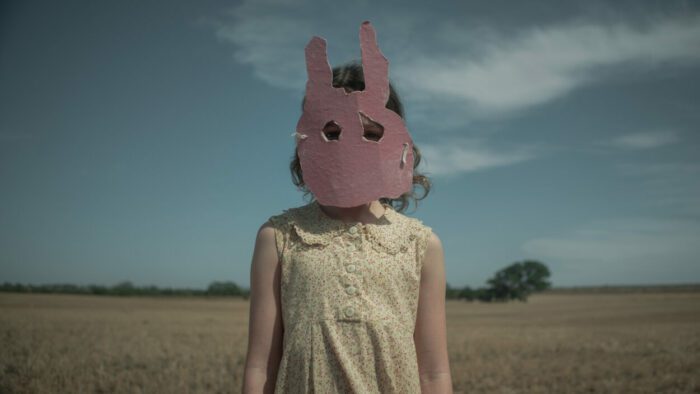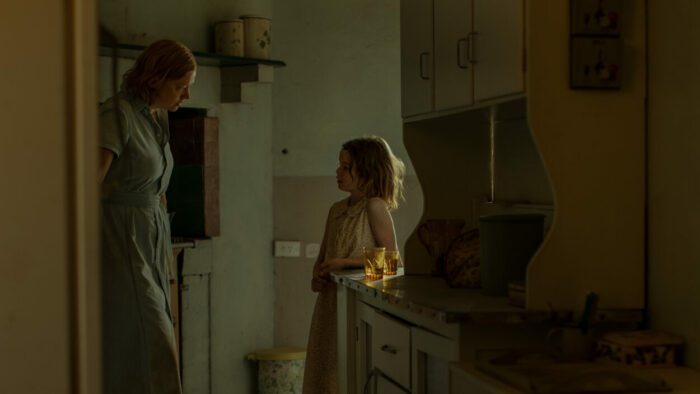If there’s one thing horror writers love, it’s an allegory. Anything in which their protagonist’s main obstacle takes the shape of… literally anything else. 2014’s The Babadook did it famously (and quite well) when its main character saw her crippling depression manifest itself as a scary monster which terrorized her and her child. More recently, 2022’s Smile took a battle with familial generational trauma and transformed it into a contagious, gnarly grin that wound up offing its victims in a way that was less-than-subtle. And who can forget David Robert Mitchell’s It Follows, which is widely accepted to be a cinematic ode to preventing STIs? The list goes on.
We can add 2023’s Run Rabbit Run to that pile: Netflix’s Australian horror/thriller is less horror than thriller… and one that’s not super thrilling, at that. The film follows Sarah (Succession’s Sarah Snook), a single mom who works as a fertility doctor in the glummest looking depiction of Australia that you ever will see. It immediately ticks all the typical must-have horror trope boxes: a dull, muted color palette; a quiet, creepy child; and a plot unfolding in the path of an ominous-looking storm. We learn our protagonist Sarah has a cordial, almost friendly relationship with her ex Pete (Damon Herrimon), with whom she shares a cute, slightly off putting young daughter named Mia (Lily LaTorre). Not for nothing, LaTorre holds her own in the role, even up against Snook’s obvious solid acting chops.

The creep factor gets upped considerably when seven-year-old Mia finds a white domestic rabbit outdoors and insists on keeping it—something which Sarah is reluctant to allow. It’s not a cute bunny rabbit, either. It’s the kind with weird, beady eyes, and Sarah’s failed attempt to get rid of it by chucking it over the backyard fence only seems to strengthen the animal’s resolve to hang around.
Things really start to feel amiss when Sarah, enduring a semi-awkward dinner date with Pete and his new partner, learns the couple plans on trying for a child. “I thought we agreed Mia was going to be an only child,” Sarah quips, making it blatantly obvious that she, for whatever reason, has issues with the concept of siblings. Pete reminds her that, no, he never made such an agreement. From there Sarah’s rarely-spoken, sordid family secret is revealed, one which sends her down a rapid yet surprisingly dull insanity spiral.
Mia begins stubbornly claiming that her name is really Alice—an insistence that seems nonsensical until we learn that Alice is, in fact, the name of Sarah’s sister who mysteriously vanished when the two were very young. Strangely, the more Sarah attempts to suppress discussions of her long-lost sister, the more that white rabbit seems to incessantly hang around—implying it is somehow intrinsically linked to the soul of little Alice, or maybe a physical manifestation of Alice’s memory that is refusing to go quietly. When Mia insists on visiting Joan, her grandmother whom she has never met and shouldn’t even know exists, it becomes obvious that we have a good old reincarnation storyline unfolding.

Sprinkled throughout Run Rabbit Run are red herrings that hint at a broader meaning or overarching theme (i.e. Alice and the white rabbit) but those fizzle out without ever being fully explored. The result is an inkling of something that could have possibly been special, but instead feels formulaic and forgettable. It’s not for lack of trying on Snook’s part, who plays the role of a troubled, tired working mom with a visceral sincerity few actresses can pull off. She’s not afraid to look less-than-perfect on camera, and that’s something I adore about her. It’s more that this bleak and somber script is not worthy of her undeniable talents. Indeed, the “twist” at the end feels less like a twist and more like a slight curve the audience spends 90 minutes begrudgingly anticipating.
I will always root for a horror film, especially one that is primarily female-driven. And while the acting is solid, unfortunately, the most jarring thing about Run Rabbit Run is hearing Sarah Snook with her native Australian accent. It’s neither scary nor does it leave its audience with any type of meaningful message, and without either of those, what even is the point? If you’re looking for a scare, seek one elsewhere. And if you’re just jonesing for some Sarah Snook, you’re better off re-watching Succession.



